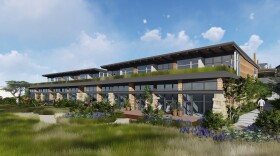
It can get to be 127 degrees Fahrenheit in the Australian town of Coober Pedy — and that's in the shade. With opal mines that look like giant ant hills and a network of underground dwellings where residents live, this is the kind of place where the searing heat warps perspectives, and yet somehow clarifies them.
The town's name comes from two aboriginal words meaning "white man in a hole." It probably works as a metaphor, but the chalky expanse of desert that surrounds Coober Pedy is marked by real holes left behind by opal prospecting.
Coober Pedy bills itself as the "opal mining capital of the world," but the town holds another, more peculiar distinction: It may have more troglodytes per capita than any other place on earth. The word here is meant literally: many people live underground, in a cave or a burrow.
Every town is caught in a tug of war between the reasons to stay and the reasons to leave. Coober Pedy has special challenges. The town is a 25-hour drive west and a bit north of Sydney, into the arid heart of Australia. But the lure of striking it rich in opal mining has kept the town flush with people over the years.
Even though the region produces four-fifths of the world's precious opal, one resident says the supply is drying up.
"The days when it was real busy here in Coober Pedy, that was in the '70s and the '80s. South Australia was producing up to about $200 million a year," says resident John Wayne Dunston. "But now, people are dropping out of the game, because all the easy opal's been found."
Still, there are people who stay. Take Peter Rowe: Even after he gave up opal mining in the 1980s, he remained in Coober Pedy. He worked as a mechanic and a tour guide, and he started taking photographs and making pottery.
"I find it very difficult to understand someone who gets up in the morning and goes to the same job, 9 to 5," Rowe says. "I'm sure a lot of people in Coober Pedy are like that."
Copyright 2022 NPR. To see more, visit https://www.npr.org. 9(MDAzMjM2NDYzMDEyMzc1Njk5NjAxNzY3OQ001))





